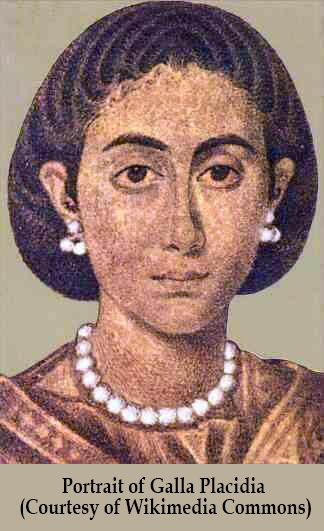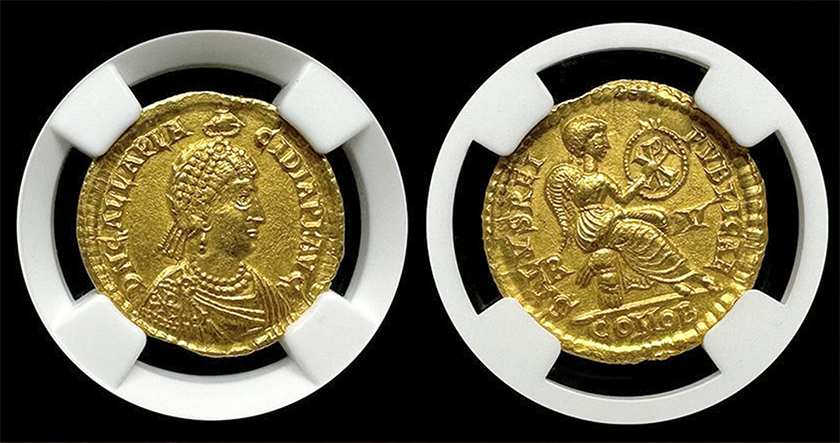Early Life and the Division of the Empire
Who was Galla Placidia? Galla Placidia, born around AD 388, was the daughter of Emperor Theodosius I and his second wife, Galla. Her early years were shaped by a rapidly changing Roman Empire. Specifically, after her father’s death in AD 395, the empire split into Eastern and Western regions. This division set the stage for the political upheaval and power struggles that would become a constant in her life
Galla Placidia’s upbringing within the Roman court afforded her a unique vantage point to observe and understand the inner workings of imperial politics. As power struggles intensified, she quickly learned the intricacies of alliances, betrayals, and strategic marriages. Despite the turbulence surrounding her, Galla Placidia cultivated strong relationships with influential figures in both the Eastern and Western Roman Empires. This network proved invaluable as she grew older and eventually took on a more active role in shaping the course of Roman history. Her adaptability and political acumen would become defining traits in the turbulent world she inhabited
The Sack of Rome and Captivity
In AD 410, the Visigoths, led by King Alaric, sacked Rome, a shocking event in Roman history. During the chaos, Galla Placidia was taken captive by the Visigoths. While in captivity, she experienced a new culture and environment, eventually marrying Alaric’s successor, Ataulf. This union was more than just a marriage—it represented a significant alliance between the Roman and Visigothic worlds. Additionally, it formed a bridge between two vastly different cultures.
Despite her captivity, Galla Placidia managed to maintain her Roman identity and influence. She played a pivotal role in mediating between the Visigoths and the Roman Empire. Her marriage to Ataulf, while political, also paved the way for a more peaceful relationship between the two groups. By embracing her new role, Galla Placidia demonstrated resilience and adaptability, qualities that would define her later reign as regent and her legacy in Roman history.
Return to Rome and Political Ascension
After Ataulf’s death in AD 415, Galla Placidia returned to the Western Roman Empire. Her brother, Emperor Honorius, welcomed her back, and she soon married the Roman general Constantius III. This marriage strengthened her political influence within the Roman court. When Constantius III died in AD 421, Galla Placidia became regent for her young son, Valentinian III, who ascended to the role of emperor. As regent, she demonstrated remarkable political acumen, skillfully managing the complex dynamics of the Roman court and its rival factions
Navigating Roman Politics
Galla Placidia’s regency was marked by challenges, including internal strife and external threats. Her ability to navigate these difficulties earned her respect and influence in Roman politics. She played a key role in maintaining stability during a turbulent period in the Western Roman Empire. Her leadership helped guide the empire through a time of uncertainty, proving her resilience and adaptability in the face of adversity.
During her regency, Galla Placidia faced the threat of rebellion and the constant pressure from invading barbarian groups. Despite these hurdles, she was instrumental in keeping the Western Roman Empire from collapsing entirely. Galla Placidia forged crucial alliances with powerful military leaders and cultivated loyalty among the Roman elite. Her strategic political moves and deft diplomacy played a vital role in stabilizing a fractured empire, allowing for a smoother transition of power when her son, Valentinian III, came of age. Her efforts helped maintain the integrity of Roman rule during a critical period of decline and upheaval.
 Galla Placidia as Empress
Galla Placidia as Empress
Galla Placidia ascended to the role of Empress when she married Constantius III in AD 421. This union not only solidified her position within the Roman imperial court but also elevated her influence. Constantius III was co-emperor with her brother, Honorius, but his reign was short-lived, passing away within the same year of their marriage. However, Galla Placidia retained her title as Empress Dowager, a position that granted her considerable authority in the Roman court.
The unexpected death of her husband thrust Galla Placidia into a more significant role in Roman politics. As Empress Dowager, she was responsible for guiding the Western Roman Empire during a challenging and chaotic period. This role was especially crucial when her son, Valentinian III, became the rightful heir to the throne. During her regency, she played an instrumental role in managing the empire’s internal conflicts and external threats, cementing her place in Roman history as a pivotal figure who helped steer the empire through turbulent times.
Legacy in Art and Religion
Beyond her political role, Galla Placidia was also known for her commitment to Christianity and her support for religious institutions. She was instrumental in constructing significant religious buildings, such as the Basilica of San Giovanni Evangelista in Ravenna. Her dedication to the faith was reflected in the religious architecture and mosaics she commissioned. These contributions have left a lasting impact on the cultural and religious landscape of the Roman Empire, preserving her legacy for generations to come.
As the Western Roman Empire faced increased turmoil, Galla Placidia’s ties to the Eastern Roman Empire grew stronger. Following the death of her second husband, Constantius III, and the political turmoil that ensued, Galla Placidia relocated to Constantinople, the burgeoning center of the Eastern Roman Empire. Her presence there influenced the development of the Eastern Empire, which would later be known as the Byzantine Empire. In Constantinople, Galla Placidia was exposed to the artistic and religious developments that defined the Byzantine style, characterized by intricate mosaics and grand religious architecture. Her connections with the Eastern Roman Empire were crucial in bridging the cultural gap between the two halves of the divided empire, fostering greater unity and cooperation.
Galla Placidia’s move to the Eastern Empire marked a significant shift in her role and legacy. She became a key figure in the formation of the Byzantine Empire’s religious and cultural identity. Her contributions to religious architecture and her influence on Byzantine art underscored the importance of Christianity in the Roman world. Through her efforts, she helped solidify the Eastern Empire’s commitment to Christianity. Therefore, laying the groundwork for the religious and artistic traditions that would become synonymous with Byzantine culture. Her legacy in both the Western and Eastern Roman Empires highlights her significant role in shaping the course of Roman and Byzantine history.
Conclusion—Who was Galla Placidia?
In conclusion, who was Galla Placidia? Galla Placidia’s life exemplifies resilience and adaptability in the face of political turmoil. Despite her captivity among the Visigoths, she forged significant alliances that bridged the gap between the Roman and Visigothic worlds. Her regency in the Western Roman Empire showcased her political acumen as she navigated internal conflicts and external threats. Her leadership helped maintain a semblance of stability during one of the most challenging times in Roman history.
Beyond her role in politics, Galla Placidia’s contributions to art and religion were substantial. Her dedication to Christianity was reflected in the religious buildings she commissioned, including the Basilica of San Giovanni Evangelista in Ravenna. These architectural marvels serve as enduring symbols of her faith and commitment to the Roman Empire’s religious and cultural heritage. Her influence also extended to the Eastern Roman Empire, where her presence played a crucial role in shaping the early Byzantine style, characterized by intricate mosaics and grand religious architecture.
In summary, Galla Placidia’s journey from captivity to regency, and her significant contributions to art and religion, demonstrate her lasting impact on Roman and Byzantine history. Her resilience and political skill not only stabilized the Western Roman Empire but also helped bridge cultural divides. Through her dedication to faith and artistic endeavors, she left a legacy that continues to inspire and remind us of the enduring strength of the human spirit.
Questions about Galla Placidia’s Coinage during Her Reign?
If you’re curious about the coins minted during Galla Placidia’s time and their significance in Roman history, you’re not alone. This era’s coinage reflects the unique blend of political and religious influences that shaped the Western Roman Empire. Each coin tells a story of a remarkable period where power dynamics and cultural transformations intersected.
To learn more about Galla Placidia’s coinage and other Roman Empire coins, watch the informative video below. Additionally, if you have any questions or need expert guidance, reach out to an Austin Coin Advisor at Austin Rare Coins & Bullion. We’re here to help you explore the fascinating history of Roman coinage and discover unique pieces that add depth to your collection. Let us guide you through the journey of ancient coins and their enduring legacy.


